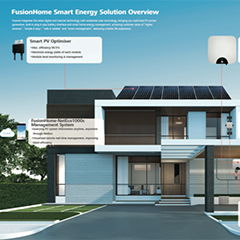More and more home owners are installing PV systems. How efficient are these systems? What does the industry need to do to support this growth area? PES takes a look at Huawei’s new, flexible solution.
Across solar markets globally, we are continuing to witness the maturation of utility scale solar, with subsidy-free commercial projects increasing in frequency. As solar’s share in global energy generation continues to rise exponentially, the industry’s ability to innovate expands too. The rapid technological developments and cost reductions that have been driven by investment in utility scale are also having a positive influence on the growth of the residential sector.
From an industry perspective, this growth has been accompanied by a proliferation of residential PV systems and technologies now available to installers and homeowners. So with residential solar now set for another significant period of expansion, it is essential that PV technology developers are able to offer systems that can handle the huge variety of customer demands across what is an increasingly competitive and crowded marketplace.
The growth of residential
Previously, residential solar was supported by necessary financial incentives in order to prove attractive to homeowners. As we look at the costs of a typical residential PV system in some of the most developed solar markets, many are now at the level that already makes economic sense on their own. Consequently, market analysts are predicting that following the rapid expansion of commercial projects, residential photovoltaic applications will be a key growth engine for the industry in the coming years. Industry experts at IHS Markit forecast that 48 GW of residential PV systems will be installed globally within the next five years, almost doubling the global installed base for residential solar to 90 GW by the end of 2021.
The growth of residential solar is just one example of how the global energy system is becoming increasingly decentralised. The use of renewable technologies and other forms of decentralised energy continue to expand, with countries moving away from traditional models of generation from conventional sources. As this system develops across markets, flexibility will be the defining characteristic of the new era of energy generation, in terms of distribution, storage and consumption.
Typically, when discussing the subject of flexibility with respect to solar, it’s in relation to how the application of digital technology and smart management have transformed an intermittent form of generation into one of the most responsive forms of electricity supply. When it comes to residential PV systems, however, it is the flexibility of system design that will be a priority for both installers and for homeowners who are looking to invest in home energy solutions.


























